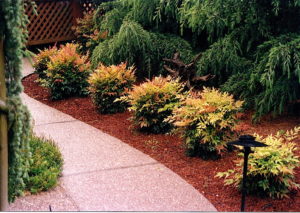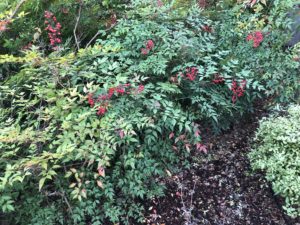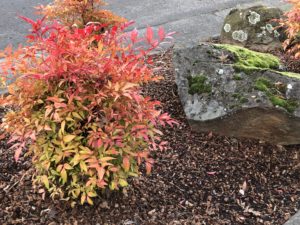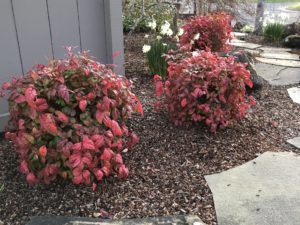Nandina domestica, commonly known as heavenly bamboo, is one of the most versatile plants in the garden. Details Landscape Art, a Sonoma County landscape design-build contractor, frequently uses the various varieties of nandina in our landscape designs.
The fine-textured leaves, cane like stems and light branching are similar to bamboo. And like bamboo, it spreads by underground suckers, but much less aggressively than bamboo.
It is a moderately fast growing evergreen, to about 6-7 feet. Nandina does well in sun or shade; the leaves will be a richer darker green in shade, and in winter, exposure to sunshine will yield a brilliant red foliage look. In extremely hot climates, nandinas will be happier with some afternoon shade. Clusters of white flowers appear in early summer, and red berries may appear throughout the year,
As it grows taller, nandina tends to become top-heavy, with the base of the plant replete with bare branches. It is a prime candidate for selective pruning. When a branch becomes too tall or top-heavy, selectively remove the entire cane from its base, leaving the shorter canes.
Native to Japan and China, the lacy leaf texture has delicate Asian feel to it, and it looks great among boulders, and alongside azaleas, hydrangeas, rhododendrons, ferns and pieris. In spite of the somewhat invasive underground suckers, which are easily controlled, nandina is a useful plant in narrow spaces, and as a foundation plant against a blank wall or a fence.
There are several varieties that we commonly use:
- Nandina ‘Compacta’ – this variety is almost identical to ‘domestica’ in habit, exposure and cultural requirements, except that it only grows to 4-5 feet tall. It therefore becomes less top-heavy and, as a result, requires less pruning. It is extremely useful in applications against the side of a house, where a foundation plant is needed, but the presence of windows may call for a shorter plant.

-
- Nandina ‘Plum Passion’ – this is a newer cultivar of nandina, similar in size and shape to ‘Compacta’. The leaves, however, are a deeper purplish red in spring and then again in winter after a green summer.
- Nandina ‘Gulf Stream’ – similar leaf look to domestica, but a denser more compact plant. Good red color in winter, grows to 3 – 3 ½ ft. tall, and looks great among groupings of boulders. We use ‘Gulf Stream’ frequently in plantings with Lomandra ‘Breeze’ and moss-covered boulders in median strips.
- Nandina ‘Moon Bay’ – almost identical to ‘Gulf Stream’, but only grows to 2 – 2 ½ ft. tall.

- Nandina ‘Fire Power’ – this variety has a broader, softer leaf, and only grows to 2 feet tall and wide. In a sunny location the foliage in winter turns a bright red.

- Nandina ‘Harbor Dwarf’ – a ground cover version of nandina, ‘Harbor Dwarf’ stays around 2-3 feet tall and spreads more aggressively. The winter foliage is more of an orange or bronze color.
In summary, nandina is an extremely versatile plant in all its forms. It tolerates sun and shade, hardy and evergreen, and works well in narrow spaces, with a minimum of occasional selective pruning.
